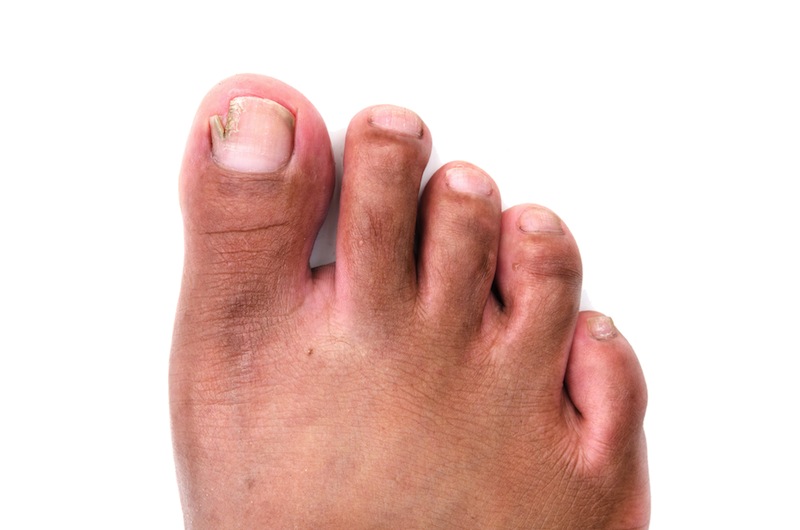Ingrown Toenail? How to Snip It the Right Way

Nobody likes ingrown toenails, and when you get one, your instinct may be to clip off the offending bit. But new research shows that might be exactly the wrong thing to do —it won't necessarily stop the toenail from growing in again, and the reason all comes down to physics.
In a new study, physicists Cyril Rauch and Mohammed Cherkaoui-Rbati, of the University of Nottingham in England, looked closely at the mechanical forces that act on fingernails and toenails, including the outward growth of the nail and the tension of its attachment to the nail bed.
Nails are made of the protein keratin, just as hair is, and are attached to the nail bed with structures that are microscopic yet quite strong. It's painful to break this attachment, as anyone who has broken a fingernail knows.
The researchers discovered that ingrown toenails result from an imbalance in the forces acting on them. Normally, nail growth imparts a force on the nail — pushing it outward toward the tip of the finger — that works against the adhesive force holding the nail down to the nail bed.
But if a nail grows too quickly, the balance between these forces changes. The additional force from the growth "pulls" on the nail bed, and in response to that pull, the nail edge becomes more curved. [10 Things You Didn't Know About You]
In addition, the shape of the nail plays a role in making it ingrown. Because fingernails are naturally curved, the outer edges are shorter than the center. This means the rates of growth in the different parts of the nail are slightly different — the center grows a bit slower than the edges do.
"The distal part — that's the separation between the white and pink part — has a curved shape. That's creating the stresses," Rauch told Live Science.
Sign up for the Live Science daily newsletter now
Get the world’s most fascinating discoveries delivered straight to your inbox.
Eventually, this stress causes the far edge of the nail to poke down into the skin alongside the nail, leading to an ingrown nail, the researchers found. Themedical name for the condition is onychocryptosis.
These forces are also the reason that the big toe seems especially prone to ingrown nails, Rauch said. "This curvature [on the edge of the big toenail] is very flat. By being flattened, these [nails] will generate stress in the transverse direction," he said. In other words, because the edge of this toenail tends to be straighter, the rate of growth in a big toe needed to push the edge of the nail into the skin doesn't need to change as much as it does for other nails.
To snip or not to snip?
So, why is it not always helpful to cut the ingrowing edge of the nail? Because cutting doesn't always rebalance the forces acting on the nail. When you cut off the end of the nail, depending on the shape of the cut, you change the nail's shape. But the faster- and slower-growing parts of the nail will keep growing at the same rates, so the change in the shape might get the nail to grow correctly — or it might not.
The best option seems to be to cut the nail in a parabolic shape, such as an oval, or to cut the edge so that it is slightly curved, rather than straight across at the end of the nail, the researchers said. That method seems to cause the force on one part of the nail and bed to balance the forces from the other parts, they added.
Rauch noted that pregnant women and children tend to get ingrown toenails more often than other groups of people. That may be because there's generally more growth happening in the nails for both of those groups, he said.
But the research has an objective besides helping people fix or prevent ingrown toenails, and it has to do with agriculture. Horses' and cows' hooves are made of the same material as fingernails, and the forces that act on them are similar.
Learning how to manage those forces is important for farmers, because hoofed farm animals can become lame from abnormal hoof growth. "It causes the animals a lot of pain," and it's very costly to agriculture, Rauch said. "Right now, it's possible to mitigate the problem for the animals, but not to cure it."
That doesn't mean that your horse needs a manicurist, but it does suggest that it is possible to trim hooves in ways that help more than current methods do.
A paper outlining the research appeared in the Oct. 17 issue of the journal Physical Biology.
Follow Live Science @livescience, Facebook & Google+. Originally published on Live Science.











